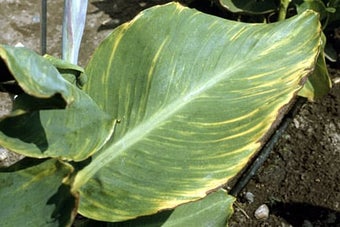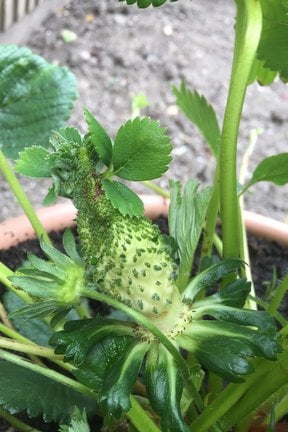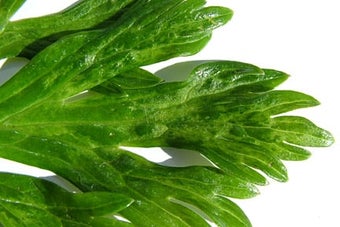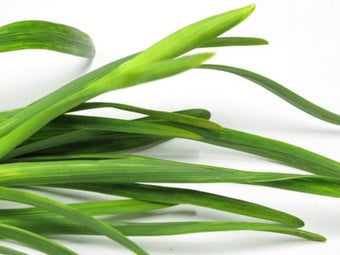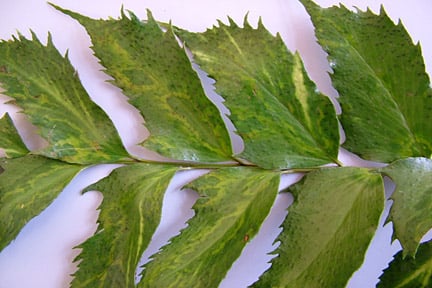
Quick facts
Common name - Plant viruses
Scientific name - Various
Plants affected - Many
Main symptoms - Leaf, shoot, stem and flower discolouration and distortion
Caused by - Viruses
Timing - Various
What are plant viruses?
Pathogenic plant viruses can have a significant negative impact on plants by causing a wide range of symptoms including discolouration, distortion and loss of vigour and yield. With very few control options, virus infection in garden plants can be a nuisance for gardeners.
International expansion in the trade of an ever-increasing diversity of plant species and cultivars is helping to spread an increasing number and diversity of plant viruses around the globe. During plant production, viruses are mainly spread from plant-to-plant via vegetative propagation, although viruses are also frequently moved globally via seed. Understanding the diversity of pathogenic viruses associated with horticultural plants is an ongoing challenge for plant pathologists.
While plant viruses are generally thought of as disease-causing entities, recent work has shown that many viruses actually play an important and beneficial role for plants, especially in extreme environments in which they are involved in conferring tolerance to drought, cold and hot soil temperatures. Some viruses actually increase the desirability of a plant, for example Abutilon mosaic virus, which causes an attractive mosaic pattern in the leaves of forms of the flowering maple (Abutilon pictum), such as 'Thompsonii'.
There is a long list of the ‘beautiful viruses’ and many prized ornamentals owe their value, at least in part, to the viruses that infect them. If you would like to read more about the positive benefits of these plant viruses for ornamentals click here.
Symptoms
Symptoms will vary depending on the virus and the plant. The photo gallery below shows a range of symptoms on leaves, flowers and fruit.
You may see the following symptoms:
- On leaves: Pale green or yellow (chlorotic) patterns including spots, streaks, mottle, mosaic and oakleaf patterns, ring spots, vein clearing (the leaf veins themselves become pale or colourless) or vein banding (the areas immediately adjacent to the veins are paler or a different colour). Ocassionally the areas affected by these various symptoms are other colours, such as red or purple. There may be spots of brown, dead (necrotic) tissue. You may also see narrowing of leaves, stunted growth or distortions, sometimes with very reduced surfaces between the veins (puckering), resembling damage by weedkillers. Leaves may be also be rugose (wrinkled), rolled, or bent down (epinasty)
- On shoots: Tufts of stunted stems (known as witches’ brooms, although these can also have other causes), yellow or brown streaks or spots on stems
- On flowers: Small or distorted flowers. Streaks of a second colour (most often white) in the petals (‘breaks’)
- On fruit: Distortion and irregular colour patterns such as marbling or ringspots, and malformed contents

Control
Non-chemical control
- If the virus is not affecting the appearance of the plant drastically and you can tolerate the symptoms, you may decide to keep the plant.
- Infected plants can act as a reservoir for infection, however. This is especially true for viruses with a large host range such as Cucumber mosaic virus and Tomato spotted wilt virus. In this instance, you may prefer to destroy the plant to prevent further spread. You may also decide to destroy a plant where its appearance has been severely affected by virus infection.
- Keep gardens weed-free, as weeds can be reservoirs of virus infection for garden plants
- Wash hands and tools after handling suspected infected plants. The disinfectant Virkon S, available from agricultural supply merchants, is recommended for tools
- Do not propagate from any plant suspected of virus infection
- Raise plants from seed where possible, as only a minority of viruses are transmitted through seed
- If buying plants rather than seed, try to source certified virus-free material (e.g. for fruit crops)
- Much work has been done on virus resistance, especially in food crops, so try to source seed or plants of resistant cultivars
Chemical control
There are no chemical controls for plant viruses. It is not practicable to control the virus insect vectors such as aphids with the non-persistent insecticides available to gardeners.
Biology
Plant viruses are extremely minute infectious particles consisting of a protein coat and a core of nucleic acid. They have no means of self-dispersal, but rely on various vectors (including humans) to transmit them from one host to another. Once viruses penetrate into the plant cells they take over the cells’ nucleic acid and protein synthesis systems and ‘hijack’ them to produce more virus.
Plant viruses come in all shapes and sizes from small round (isometric) particles to rigid rod-shaped, bullet-shaped and long and flexuous, depending on the viral species.
Virus infections in plants can cause quite dramatic symptoms but, more often than not, they can be mild and sometimes even symptomless. Virus symptoms are seen more often in the spring when the temperature warms and the plant becomes active. With some viruses and plant species, virus symptoms may be transient in that they disappear later in the when the temperature increases further.
Viruses rarely kill plants, and usually plants can tolerate infections if they are grown well and kept in good health and vigour.
Viruses have no means of movement and generally rely on other organisms (vectors) to transmit them from diseased to healthy plants. These are often -sucking insects such as aphids, thripsand whiteflies. Other vectors include leaf-feeding beetles, plant-feeding mites, soil-inhabiting nematodes (eelworms), and root-infecting fungal and fungus-like organisms (e.g. Olpidium and Polymyxa species). Some viruses are also very contagious and can be transmitted on pruning knives or gardeners’ hands. Viruses are also transmitted from one plant generation to the next via infected or grafted material (vegetative propagation) and a relatively small number can pass through infected seed or pollen.
Plant viruses can be transmitted in different ways by insects, depending on the length of time the vector can harbour the infectious particles. Thus transmission is classified as non-persistent (minutes to hours), semi-persistent (days), and persistent (life-time and passed onto progeny).
Many viruses are unable to survive long outside their host plant or vector and are rapidly killed by exposure to the heat and ultra-violet light in sunlight. However, some are robust enough to survive and be transmitted via pruning tools, and a few can survive .
The host ranges of some viruses are very wide, others are specific or restricted to a few closely-related plants. Plants may be infected by a single virus or more than one virus at any one time. The symptoms that a plant exhibits are determined by which viruses are present, the relative proportions of each, the order in which they infected the plant, the plant’s natural resistance to the strains of the viruses, and the environmental conditions: some symptoms are temperature dependent, for example. Some virus infections are symptomless, allowing symptomless infected plants to act as reservoirs of infection.
A note on virus names: Viruses are named according to the type of symptom they cause in the first host in which they were discovered, though this is often only the first of many. Thus, Bean yellow mosaic virus actually infects a wide range of plants as well as beans; some are in the family Iridaceae, completely unrelated to legumes.

















